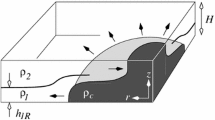Abstract
Laboratory experiments are conducted to examine a descending plume in a rotating two-layer stratified ambient fluid such that the plume at the interface has moderate to large Rossby number. While the source fluid is more dense than the lower layer, the experiments are designed so that the mean density of the plume fluid impinging upon the interface is less than the lower layer density, as represented by a buoyancy parameter, \(\varLambda \), being less than unity. In such cases, the discharged plume fluid spreads radially at the interface in the form of an intrusive gravity current at early times. At later times, this intrusion evolves to form an anticyclonic lens due to the influence of the Coriolis force. The measured radial position of the intrusion front, R(t), follows different power law relationships at early and late times during the spread of the intrusion: at early times when rotation does not play a significant role the power law exponent lies between 0.5 and 1.1; at late times when the intrusion acts as a rotationally influenced expanding lens the power law exponent ranges between 0.15 and 0.5, with generally smaller values for larger \(\varLambda \). The plume fluid reaching the interface progressively increases in density due to re-entraining relatively dense fluid as the plume descends within the thickening lens. Consequently, the plume eventually penetrates through the interface and descends to the bottom of the tank. Faster rotation makes the lens thicker and hence increases the volume of the re-entrained lens-fluid, which decreases the time for the onset of penetration. The penetration time normalized by the rotation rate is found to hold a simple power law relationship with \(\varLambda \).








Similar content being viewed by others
References
Ayotte BA, Fernando HJS (1994) The motion of a turbulent thermal in the presence of background rotation. J Atmos Sci 51(13):1989–1994
Baines PG, Sparks RSJ (2005) Dynamics of giant volcanic ash clouds from supervolcanic eruptions. Geophys Res Lett 32:L24808.
Baines WD, Turner JS (1969) Turbulent buoyant convection from a source in a confined region. J Fluid Mech 37:51–80
Britter RE (1979) The spread of a negatively buoyant plume in a calm environment. Atmos Environ 13(9):1241–1247
Bush J, Woods AW (1999) The generation of coherent vortices by line plumes in rotating stratified fluid. J Fluid Mech 614:15–37
Carazzo G, Kaminski E, Tait S (2006) The route to self-similarity in turbulent jets and plumes. J Fluid Mech 547:137–148
Colomer J, Zieren LD, Fernando HJS (1998) Comment on “Locaalized convection in rotating stratified fluid” by J. A. Whitehead et al. J Geophys Res 103(C6):12891–12894
Ezhova E, Cenedese C, Brandt L (2016) Interaction between a vertical turbulent jet and a thermocline. J Phys Oceanogr 46:3415–3437
Ezhova E, Cenedese C, Brandt L (2017) Dynamics of a turbulent buoyant plume in a stratified fluid. J Phys Oceanogr 47:2611–2630
Fernando HJS, Chen Rr, Ayotte BA (1998) Development of a point plume in the presence of background rotation. Phys Fluids 10(9):2369–2383
Fernando HJS, Ching CY (1993) Effects of background rotation on turbulent line plumes. J Phys Oceanogr 23:2125–2129
Frank D, Landel JR, Dalziel SB, Linden PF (2017) Anticyclonic precession of a plume in a rotating environment. Geophys Res Lett 44(18):9400–9407.
Griffiths RW, Linden PF (1981) The stability of vortices in a rotating, stratified fluid. J Fluid Mech 105:283–316
Helfrich KR, Battisti TM (1991) Experiments on baroclinic vortex shedding from hydrothermal plumes. J Geophys Res 96(C7):12511–12518
Hunt GR, Kaye NG (2001) Virtual origin correction of lazy turbulent plumes. J Fluid Mech 435:377–396
Hunt GR, Linden PF (2001) Steady-state flows in an enclosure ventilated by buoyancy forces assisted by wind. J Fluid Mech 426:355–386
Kaye NB, Hunt GR (2007) Overturning in a filling box. J Fluid Mech 576:297–323
Kumagai M (1984) Turbulent buoyant convection from a source in a confined two-layered region. J Fluid Mech 147:105–131
Lemckert C, Imberger J (1993) Axisymmetric intrusive gravity currents in linearly stratified fluids. J Hydraul Eng ASCE 119:662–679
Ma Y, Flynn MR, Sutherland BR (2017) Convection from a line-source into a two-layer stratified ambient fluid. J Fluid Mech 818:46–67
Morton BR, Taylor GI, Turner JS (1956) Turbulent gravitational convection from maintained and instantaneous sources. Proc R Soc Lond Ser A 234:1–23
Mott RW, Woods AW (2009) On the mixing of a confined stratified fluid by a turbulent buoyant plume. J Fluid Mech 623:149–165
Okada N, Ikeda M, Minobe S (2004) Numerical experiments of isolated convection under polynya. J Oceanogr 60(6):927–943
Richards TS, Aubourg Q, Sutherland BR (2014) Radial intrusions from turbulent plumes in uniform stratification. Phys Fluids 26(036602):1–17.
Rooney GG (2015) Descent and spread of negatively buoyant thermals. J Fluid Mech 780:457–479
Rooney GG, Devenish BJ (2014) Plume rise and spread in a linearly stratified environment. Geophys Astrophys Fluid Dyn. 108(2):168–190
Scase MM, Baldwin KA, Hill RJA (2017) Rotating Rayleigh–Taylor instability. Phys Rev Fluids 2:024801
Tomàs AF, Poje AC, Özgökmen TM, Dewar WK (2016) Effects of rotation on turbulent buoyant plumes in stratified environments. J Geophys Res 121(8):5397–5417
Whitehead JA, Marshall J, Hufford GE (1996) Locaalized convection in rotating stratified fluid. J Geophys Res 101(C11):25705–25721
Woods AW (2010) Turbulent plumes in nature. Ann Rev Fluid Mech 42:391–412
Acknowledgements
Funding for this study was generously provided by NSERC through the Discovery Grant and RTI programs.
Author information
Authors and Affiliations
Corresponding author
Additional information
Publisher's Note
Springer Nature remains neutral with regard to jurisdictional claims in published maps and institutional affiliations.
Rights and permissions
About this article
Cite this article
Ma, Y., Flynn, M.R. & Sutherland, B.R. Plumes in a rotating two-layer stratified fluid. Environ Fluid Mech 20, 103–122 (2020). https://doi.org/10.1007/s10652-019-09696-8
Received:
Accepted:
Published:
Issue Date:
DOI: https://doi.org/10.1007/s10652-019-09696-8




